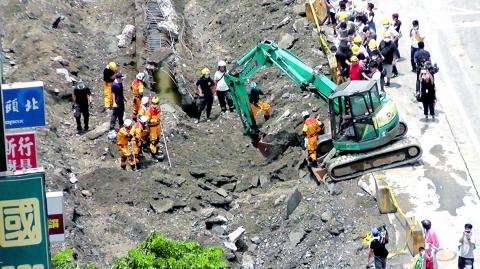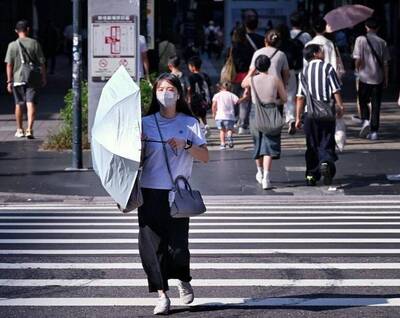Experts say that a series of gas explosions in Greater Kaohsiung late on Thursday and early Friday morning might have been due to propene gas leaking from pipes that had rusted or were out of alignment after years of use.
Retired National Taiwan University department of chemical engineering professor Shih Hsin-min (施信民) said it is difficult to gauge the strength of the explosion without knowing the amount and density of propene involved.
The nature of the explosion might be changed if propene had come into contact with methane or ethylene, which can cause an explosion to “stack” due to the additional combustible gas, Shih said, adding that the total energy of the explosion would not be multiplied.

Photo: EPA
Commenting on white smoke seen by members of the public prior to the explosion, Shih said it could have been that colder-than-air propene caused vapor to coalesce, or it may simply have been nearby restaurants or hotels pumping out hot wastewater.
Shih said on-site inspections were necessary to determine the cause of the white smoke.
Shih said that the main cause of the explosion was due to multiple leaks in gas pipes.
Pipelines carrying propene gas should be airtight and secure as propene, being denser than air, can seep out of joints in pipelines if there are even the smallest holes, Shih said, adding that sometimes gaps can develop due to rusting.
Any source of fire, even small sparks, can set off propene, and any explosion from another source can cause other pipes to leak more propene, causing a chain reaction of explosions in a given area, Shih said.
If this week’s explosion is due to the age of the pipes, the government should inspect all the pipelines that were put down in the same year to avoid further disasters, Shih said.
National Taiwan University of Science and Technology department of chemical engineering professor Liu Chih-cheng (劉志成) said that many of the nation’s pipelines are old and should be replaced, adding that some sections of pipeline had been laid down in the Japanese colonial era.
The government should make a thorough inspection of the petrochemical pipelines in Greater Kaohsiung as well as Mailiao Township (麥寮) in Yunlin County, Liu said.
Liu said that although propene was a basic material in the petrochemical industry, it was also quite combustible.
Professor Wu Chia-cheng (吳家誠) of National Taiwan Normal University’s Department of Chemistry said that the blasts were comparable to a shell launched from the main gun of a tank.
If a car weighed 1,600kg and the height of a three-story tall building was 15m, implementing the mass plus velocity equation would put the peak amount of energy of the explosion at more than 55,000 pounds per square inch (PSI), Wu said.
Average atmospheric pressure is about 14.7 PSI at sea level, but a force equating to 2,500 PSI would be able to penetrate a wall 25cm thick, Wu said, adding that with a force of 55,000 PSI the explosion could have penetrated a concrete wall 5.5m thick, roughly equivalent to a shell launched from a tank.
Wu said that that propene would have filled the sewers as it was heavier than air, adding that once it reached critical mass it would have sought a weak point in the roads for release.
The initial blast would have sent shockwaves into nearby gas lines, causing further blasts to occur, Wu said.

Foreign travelers entering Taiwan on a short layover via Taiwan Taoyuan International Airport are receiving NT$600 gift vouchers from yesterday, the Tourism Administration said, adding that it hopes the incentive would boost tourism consumption at the airport. The program, which allows travelers holding non-Taiwan passports who enter the country during a layover of up to 24 hours to claim a voucher, aims to promote attractions at the airport, the agency said in a statement on Friday. To participate, travelers must sign up on the campaign Web site, the agency said. They can then present their passport and boarding pass for their connecting international

Temperatures in northern Taiwan are forecast to reach as high as 30°C today, as an ongoing northeasterly seasonal wind system weakens, the Central Weather Administration (CWA) said. CWA forecaster Tseng Chao-cheng (曾昭誠) said yesterday that with the seasonal wind system weakening, warmer easterly winds would boost the temperature today. Daytime temperatures in northern Taiwan and Yilan County are expected to range from 28°C to 30°C today, up about 3°C from yesterday, Tseng said. According to the CWA, temperature highs in central and southern Taiwan could stay stable. However, the weather is expected to turn cooler starting tonight as the northeasterly wind system strengthens again

COOLING OFF: Temperatures are expected to fall to lows of about 20°C on Sunday and possibly 18°C to 19°C next week, following a wave of northeasterly winds on Friday The Central Weather Administration (CWA) on Sunday forecast more rain and cooler temperatures for northern Taiwan this week, with the mercury dropping to lows of 18°C, as another wave of northeasterly winds sweeps across the country. The current northeasterly winds would continue to affect Taiwan through today, with precipitation peaking today, bringing increased rainfall to windward areas, CWA forecaster Liu Pei-teng (劉沛滕) said. The weather system would weaken slightly tomorrow before another, stronger wave arrives on Friday, lasting into next week, Liu said. From yesterday to today, northern Taiwan can expect cool, wet weather, with lows of 22°C to 23°C in most areas,

Taiwan sweltered through its hottest October on record, the Central Weather Administration (CWA) said yesterday, the latest in a string of global temperature records. The main island endured its highest average temperature since 1950, CWA forecaster Liu Pei-teng said. Temperatures the world over have soared in recent years as human-induced climate change contributes to ever more erratic weather patterns. Taiwan’s average temperature was 27.381°C as of Thursday, Liu said. Liu said the average could slip 0.1°C by the end of yesterday, but it would still be higher than the previous record of 27.009°C in 2016. "The temperature only started lowering around Oct. 18 or 19